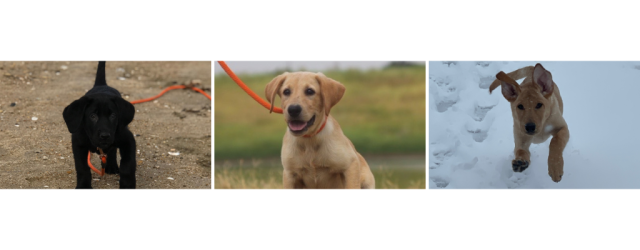
Labrador Retrievers
Looking back at the joy my Labrador Retrievers have provided me at home and in the field is no wonder Labs are one of the most beloved dog breeds in the world. They are loyal, eager to please and affectionate dogs that make great pets, as well as excellent hunting companions. My family has been so lucky with the handful of Labs we have owned. It has always amazed me how the individual personalities of all our labs have differed, but one thing they always have in common is the unconditional relationship (love) they offer. Now, don’t get me wrong some of the most frustrating days of my life have come while training my Labrador Retrievers, but that is probably on me not them.
I have never had a Lab that wasn’t a goof ball. Many people say that dogs take on the traits of their owners so maybe there is something to that. But with friendly, outgoing personalities Labrador Retrievers are very social dogs who really thrive on human interaction. Whether our Labs are in the house or in kennels they are always part of the family. They seem to know what it is their humans need. I have had many conversations with my Labs in an old busted up Barn we used to own. Never once answered me back, but they were always looking at me and listening to what I was saying. Other times I’ll walk into the living room to find one of my daughters snuggled up with one of them. Most of the time however it’s a raucous noise that brings me into the room and one of the girls and Labs are holding a WWF wrestling match.
As goofy and fun loving as the Labrador Retriever is, the second we get out training aids, shot guns or even put on camo hunting clothes their personalities change like a light switch. They absolutely love to work. The main reason for this is genetics, we have labs with great field bred bloodlines. Labradors love their jobs as retrievers, search and rescue or detection dogs. Their eagerness to please, energetic and active personalities make them a great working dog who also loves being part of the family.
Important to note that there are slight differences between American Labs and British Labs as well as noticeable differences between pedigrees. First, American vs British Labs. American Labs tend to be more constant in their energy levels, some might say high strung, while British Labs are more laid back. British Labs tend to be more methodical in their movements while retrieving and American Labs operate at a quicker pace. Pedigree or bloodline plays a HUGE role on Labrador Retrievers personalities and temperament. Field bred Labradors are going to be high energy while confirmation or “pet” lines will be more docile.
The physical characteristics of a Labrador Retriever are going to change based on pedigree, however we can make some generalizations. Most of the time the average Lab will weigh between 55 and 80 pounds. Now it is our responsibility to keep our dogs in their optimum weight range. For a Lab we want to see a nice curve inward from the rib cage to the hips and just be able to see the ribs. Maintaining weight on your Labrador is essential to long term health.
They have a thick short coat that has two layers which helps them stay almost waterproof. The top coat is coarse and sometimes oily, while the bottom coat is softer and works as a warming and cooling coat. The conditions that we ask many of our working labs to endure require both a warm waterproof coat and a cooling coat in the warmer months.
Labradors have a strong, muscular build that allows them to perform in a variety of situations we ask of them. I have never had a Lab that didn’t love the water. We’ve had a couple that maybe liked it too much. One thing you’ll notice about all Labs is their “Otter Tail.” They have a thick tail that helps them swim. Labs have been bred for high endurance allowing them to handle highly demanding physical activity.
Finally we get into colors. Many people will claim that one color shows better traits than others, but that is simply not true. Genetics may help form that judgment as the “B” and “E” genes get tossed into alphabet soup…more on that in a later discussion. The three Labrador colors are Black, Yellow and Brown. There are more Black Labs than yellow and more Yellow Labs than Brown. Whatever the color, their pedigree is what impacts their physical and mental traits.
Whether you want a working dog or an awesome house pet, please have a plan for physical and mental exercise. You will want to burn off some energy every day. Great exercise includes walks, runs, swimming or retrieving. Another fantastic option is obedience or field training.
Labrador Retrievers are one of the most trainable dogs on the planet. Their intelligence level, eagerness to please and years of genetics allow them to excel at obedience and field work. There are some great obedience programs at local pet stores or private training groups and some online. If you are interested in hunting or field work there are tons of local clubs that you can join. Check out the AKC Performance Clubs. Another great options, probably in conjunction with a club, gives you step by step training guidance.

The health and longevity of your Labrador Retriever is based on decisions you make. Labs are generally healthy dogs. When looking for your new fluff ball, make sure you are buying from a reputable breeder. Look for health clearances and guarantees. Once your Lab arrives, diet and exercise is essential. It is also your responsibility to provide basic obedience training so that your dog can be safe in his or her environment.
Labs generally live about 12 years. They have some health conditions to be aware of. Hip and elbow dysplasia, obesity and if in the water ear infections. These conditions all can be minimized or eliminated if you as the owner make good decisions. Selecting a good pedigree where both parents are scored by the OFA [link] for at least hips, elbows and EIC. We can eliminate obesity by providing a proper diet (no table scraps no matter how cute they are) and daily exercise. Regular vet care for check-ups, vaccinations and preventative care will definitely help the quality and longevity of your Labrador Retriever.
It is no surprise why the Labrador Retriever has been America’s favorite dog for as long as I can remember. Once you own one you’ll know why they are so loved. My family has had primarily field labs, but they have all been in and out of the house and we would absolutely consider them part of our family. Just remember when selecting a puppy and bringing them into your lives for the next 12 plus years, just a couple simple steps can provide you and your pup a happy and healthy life.


